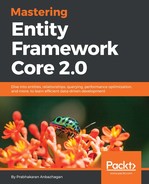We started by exploring what is a concurrency conflict, and how Microsoft would have handled them in the Entity Framework implementation. We have seen how the concurrency token implementation would solve our issue, and then started with using concurrency tokens with the non-timestamp approach. Later, we used the timestamp-based concurrency token to catch the conflicts. Finally, we have found ways to handle those concurrency conflicts using both optimistic and pessimistic approaches. We can choose between the two based on our priority; if performance is vital to the project then pick optimistic concurrency, or if the business users are keen on data and are ready to have a trade-off with performance, then pick pessimistic concurrency. We have built the blogging system to illustrate certain features covered in the book, but it was not created to provide better performance. We might have used approaches that would yield better performance through muscle memory, but it's time to explore all possible options available in the framework to improve the application's performance. Let's explore them in Chapter 11, Performance – It's All About Execution Time.
- Preface
- Kickstart - Introduction to Entity Framework Core
- The Other Way Around – Database First Approach
- Relationships – Terminology and Conventions
- Building Relationships – Understanding Mapping
- Know the Validation – Explore Inbuilt Validations
- Save Yourself – Hack Proof Your Entities
- Going Raw – Leveraging SQL Queries in LINQ
- Query Is All We Need – Query Object Pattern
- Fail Safe Mechanism – Transactions
- Make It Real – Handling Concurrencies
- Performance – It's All About Execution Time
- Isolation – Building a Multi-Tenant Database
Summary
-
No Comment
..................Content has been hidden....................
You can't read the all page of ebook, please click here login for view all page.
